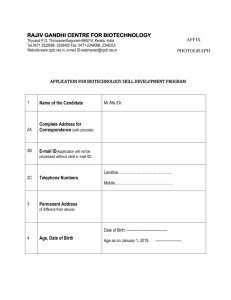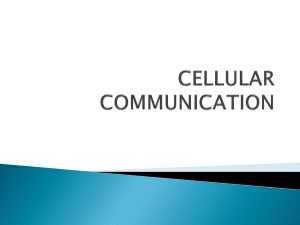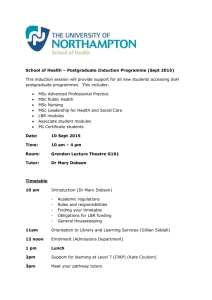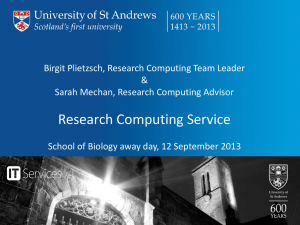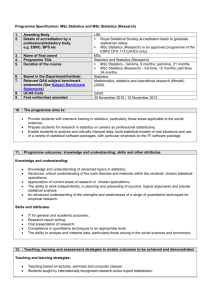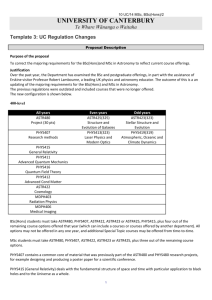Cellular systems & GSM Wireless Systems, a.a. 2014/2015
advertisement
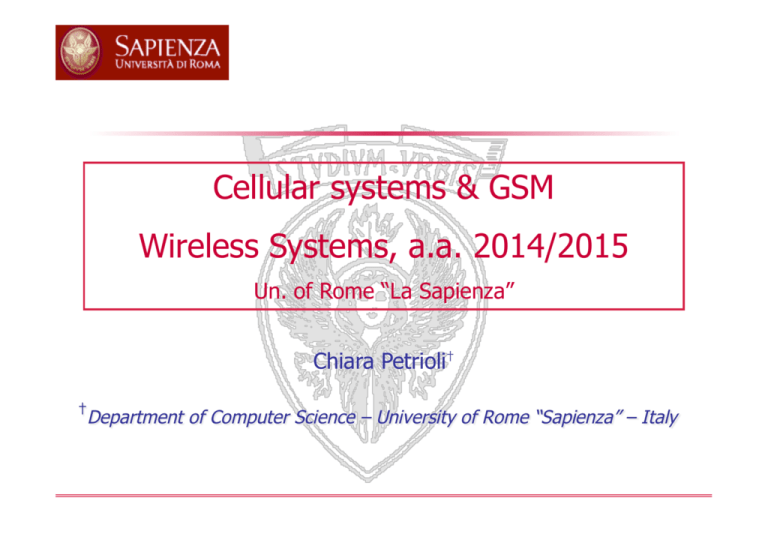
Cellular systems & GSM Wireless Systems, a.a. 2014/2015 Un. of Rome “La Sapienza” Chiara Petrioli† †Department of Computer Science – University of Rome “Sapienza” – Italy Logical Channels • Uniquely identify the type of information they carry: – Signaling (e.g., synchronization info, ...) – Data traffic • Channels types: – Traffic channels vs. control channels – Common channels vs. dedicated channels 2 Logical Channels LOGICAL CHANNELS FCCH COMMON DEDICATED CHANNELS CHANNELS Broadcast Common Dedicated CONTROL TRAFFIC CONTROL CONTROL CHANNELS CHANNELS CHANNELS CHANNELS SCH BCCH PCH RACH FCCH=Frequency Correction CHannel SCH=Synchronisation Channel BCCH=Broadcast Control CHannel PCH=Paging CHannel RACH=Random Access CHannel AGCH=Access Grant CHannel AGCH SDCCH SACCH FACCH TCH/F TCH/H TCH/E SDCCH=Stand-alone Dedicated Control CHannel SACCH=Slow Associated Control CHannel FACCH=Fast Associated Control CHannel TCH/F=Traffic CHannel Full rate TCH/H=Traffic CHannel Half rate TCH/E=Traffic CHannel Enhanced Full rate 3 Control Channels-CCH • Control channels carry signaling information (14 types of control channels are defined!!) • Three main categories of CCH: – Broadcast Channels (BCH): unidirectional downlink channels providing general information about the network – Common Control Channels (CCCH): carry information for initiating a connection (shared between multiple connections) – Dedicated Control Channels (DCCH): carry signaling information specific for a single connection FCCH 4 Broadcast Common Dedicated CONTROL CONTROL CONTROL CHANNELS CHANNELS CHANNELS SCH BCCH PCH RACH AGCH SDCCH SACCH FACCH Broadcast Channels - BCH • FCCH (Frequency Correction Channel): downlink channel used to correct MS frequency, 148 bits without coding • SCH (Synchronization Channel): carry the Base Station Identity Code (BSIC) and the frame number (FN), 25 bits + channel coding • BCCH (Broadcast Control Channel): carry general information that are broadcasted to all user of a base station, 184 bytes after coding (parameters of the frequency hopping algorithm, number of common control channels allocated, number of blocks for the AGCH channel, etc.). Broadcast CONTROL CHANNELS 5 Common Control Channels - CCCH • PCH (Paging Channel): downlink channel used by the BTS to notify an incoming call to a MS, broadcasted over a LA • RACH (Random Access Channel): uplink channel used by a MS to request access to the network (Location Update, call request). Prone to collisions. • AGCH (Access Grant Channel): downlink channel carrying reply to RACH requests. Common CONTROL CHANNELS 6 Random Access Channel (RACH) • Access to the RACH channel is random, i.e., not coordinated with other MSs • The RACH channel is thus prone to collisions • Access messages that are correctly received by the BS are acknowledged on the AGCH channel • RACH messages include a temporary pseudo-random sequence that is included on the acknowledgment sent on the AGCH channel 7 Random Access Channel (RACH) • Access to the RACH channel is random, i.e., not coordinated with other MSs • The RACH channel is thus prone to collisions • Access messages that are correctly received by the BS are acknowledged on the AGCH channel • RACH messages include a temporary pseudo-random sequence that is included on the acknowledgment sent on the AGCH channel • Transmissions on the RACH channel use the Slotted-ALOHA protocol 8 Dedicated Control Channels – DCCH • SACCH (Slow Associated Control Channel): bidirectional channel used to exchange connection metrics between MS/BS and BS/MS (e.g., received signal strength, quality….). Multiplexed with user traffic (184 bits) • FACCH (Fast Associated Control Channel): used for exchange of time critical information (urgent handover request). The FACCH transmits control information by “stealing” capacity from the associated traffic channel. • SDCCH (Stand-alone Dedicated Channel): stand-alone dedicated control channel that is assigned after a RACH request (authentication messages, call set-up…) Dedicated CONTROL CHANNELS 9 Slow Associated Control Channel (SACCH) • Downlink: – Power control commands – BCCH information (that can no longer be decoded by the MS after it switches to the traffic channel) • Uplink: MS measurements report: – RXLEV-SERVING-CELL (signal strength from own BTS) RXQUAL-SERVING-CELL (downlink BER) – RXLEV-NCELL “N” (signal strength from adjacent cells) – BCCH-FREQ-NCELL “N” (# BCCH carrier of adjacent cells) – BSIC-NCELL “N” (BSIC of adjacent cells) Dedicated CONTROL CHANNELS 10 Set-up of a traffic channel The MS tunes to a BTS and synchronizes with the frame Mobile BS BCCH RACH AGCH SDCCH TCH + SACCH 11 structure in its cell by using FCCH, SCH, and BCCH. general information about the network, the cell in which the MS is currently located and adjacent cells access request SDCCH assignment traffic signaling + TCH assignment Traffic Channels-TCH • Traffic channels (TCH) carry speech and data • Two types of TCH: – Full Rate channels: gross rate of 22,8 Kb/sec (including coding incorporated for error protection) – Half Rate channels: gross rate of 11,4 Kb/s Frame 1 Full Rate Half Rate 12 Tf Frame 2 Tf Tf t Th Th slot Th Th t Channel coding: voice channel at 13 Kb/s • Bit of the 4 physical blocks of 114 bit are not the contiguous output of the coding process • Instead, bits are interleaved: Interleaving B(i,1) B(i,2) B(i,3) B(i,4) B(i+1,1) B(i+1,2) B(i+1,3) B(i+1,4) ... B(i+3,3) B(i+3,4) Interleaving B(i,1) B(i+1,1) B(i+2,1) B(i+3,1) 13 B(i,2) B(i+1,2) B(i+2,2) B(i+3,2) ... B(i,4) B(i+1,4) B(i+2,4) B(i+3,4) Mapping of logical channels onto physical channels • Signaling requires lower bit rates than user transmissions (it wouldn’t be efficient to assign a whole slot per frame to signaling) • Actual transmission rate may be reduce by using multiframes • IDEA: slots are associated with IDs, and may be assigned over a period of multiple frames, i.e., over a multiframe Frame 1 0 1 2 Frame 2 31 32 33 34 multiframe 14 63 64 65 66 0 1 2 Multiframe example: SACCH • A normal data burst carries 114 bits of data 148 bit = 546.12 µs T Coded bits S Training Sequence S Coded bits T 3 57 1 26 1 57 3 Guard Period 8.25 577 µs • A channel using one slot per frame has a rate of 114 [bit]/ 4.6 [ms]=24.7 Kb/s • Coded speech is transmitted at a rate of 22,8 Kb/s • 1,9 Kb/s are not used, equal to 1 SLOT every 13 frames • SACCH: 1 SLOT every 26 frames = rate of 950 bit/sec. 15 SACCH Signaling channels 0 12 25 T T T T T T T T T T T T A T T T T T T T T T T T T - • The figure shows mapping of a full-rate traffic channel (TCH) (T) and its Slow Associated Control Channel (SACCH) (A) onto one physical channel • SACCH is used for measurements exchange and commands • A super-frame of 26 frames (120 ms) is used. 16 Multiframe TCH full duplex • A temporal diagram is the sequence of slots of the same traffic channel, i.e., of a slot of a frame Downlink, Uplink T C H / F R T C H / F R T C H / F R T C H / F R T C H / F R T C H / F R T C H / F R T C H / F R T C H / F R T C H / F R T C H / F R T C H / F R S A C C H T C H / F R T C H / F R T C H / F R T C H / F R T C H / F R T C H / F R T C H / F R T C H / F R T C H / F R T C H / F R T C H / F R T C H / F R I D L E 0 1 2 3 4 5 6 7 8 9 10 11 12 13 14 15 16 17 18 19 20 21 22 23 24 25 0 1 2 3 4 5 6 7 Normal Normal Normal Normal Normal Normal Normal Normal burst 577 µs 17 burst burst burst burst 4,615 ms burst burst burst Multiframe TCH half duplex Downlink, Uplink T C H / F R T C H / F R T C H / F R T C H / F R T C H / F R T C H / F R T C H / F R T C H / F R T C H / F R T C H / F R T C H / F R T C H / F R S A C C H T C H / F R T C H / F R T C H / F R T C H / F R T C H / F R T C H / F R T C H / F R T C H / F R T C H / F R T C H / F R T C H / F R T C H / F R S A C C H 0 1 2 3 4 5 6 7 8 9 10 11 12 13 14 15 16 17 18 19 20 21 22 23 24 25 0 1 2 3 4 5 6 7 Normal Normal Normal Normal Normal Normal Normal Normal burst 577 µs 18 burst burst burst burst 4,615 ms burst burst burst Common signaling channels • A given slot (slot 0) over a given carrier (C0 or main carrier) among those associated to the cell is used to obtain one or multiple channels that use a multiframe containing 51 frames (235.38 ms). • In downlink, the main carrier is always transmitted at a power higher than the other carriers, which allows a MS to synchronize with the main carrier and to receive the information it needs for tuning to the BS. Frame 0 7 0 1 2 Frame 2 7 0 1 2 superframe 19 Frame 50 7 0 1 2 7 0 1 2 Common signalling channels • Downlink channels: ➨ Frequency Channel (FCH) ➨ Synchronization Channel (SCH) ➨ Broadcast Control Channel (BCCH) ➨ Common Control Channel (PCH, AGCH in downlink) 10 frames 0 FS B C ■ FS C C C C Uplink: Random Access Channel (RACH) RRRRRRRRRRRRRRRRRRRR 20 FS 50 frame - RRRRRRRRRR SDCCH channel • Another slot is used to obtain 8 Stand-Alone Dedicated Control Channel (SDCCH) (S) • Used for setup and other messages (SMS) • The 8 channels are obtained by using 3 slots each within the super-frame of 26 slots 0 12 25 SSSSSSSSSSSSASSSSSSSSSSSS - 21 Why 26 and 51? Last frame (idle) in TCH multiframe (Frame #25) used as “search frame”! T T T T T T T T T T T T S T T T T T T T T T T T T - An active call transmits/receive in 25 frames, except the last one. - in this last frame, it can monitor the BCCH of this (and neighbor) cell - this particular numbering allows to scan all BCCH slots during a superframe 22 Physical blocks (Bursts) • The physical block is the information transmitted during a slot • Due to TDMA, each block is an autonomous transmission entity, which should be transmitted at the appropriate power level to avoid interference with adjacent slots dB +4 +1 -1 -6 -30 -70 23 10 8 10 542.8 10 8 10 µs Bursts Classification • Normal Burst – • Used for user transmissions (speech or data) over traffic channels Access Burst – Used to transmit information over the Random Access CHannel - RACH – First-time access • Longer guard period (68,25 bit durations) to avoid overlapping of the the transmission from different mobiles; remember that mobile users do not know the timing advance at the first access (or after handover). The guard period is computed assuming a maximum cell size of 35Km. 24 Access Burst T Synchronisation Coded bits T Guard Period 8 41 36 3 68.25 577 µs • Used by the MS on the random access channel at the first access • Asynchronous access, no timing advance check • It contains 156.25 bits – 8 tailing bits To estimate – 41 synchronisation sequence timing advance – 36 coded bits – 3 tailing bits – 68.25 bits guard period 25 Normal Burst 148 bit = 546.12 µs • • • • • 26 T Coded bits S Training Sequence S Coded bits T 3 57 1 26 1 57 3 Guard Period 8.25 577 µs T-bits: tail bits always set to 0 S-bits: (stealing bits) indicate whether the burst contains user data or signaling information (SACCH or FACCH channels, only one of the two blocks may contain signaling information in case of FACCH) Coded Data: user bits (speech, data, etc.), 114 bit with channel coding, corresponding to 13 kbit/s for speech and to 9.6 kbit/s or lower for data (due to the channel coding using more bits) Training Sequence: control bits used for the equalization and tuning of the transmitters GP: guard period Bursts Types • Frequency Correction Burst – Used over the Frequency Correction Channel - FCCH – 142 bits set to “0” – Correct the frequency of the MS’s local oscillator, effectively locking it to that of the BTS • Synchronisation Burst – Used to transmit information about synchronization for slots and frames • Dummy Burst – It contains no information, only padding bits – Used when there is no information to be carried on the unused timeslots of the BCCH Carrier (downlink only) 27 Frequency Correction Burst T Fixed bit sequences T 3 142 3 Guard Period 8.25 577 µs • 148 + 8.25 bits – 2 x 3 tail control bits – 142 fixed bit sequences ü All bits set to 0 ü a pure sine wave is transmitted, which is the frequency with which the MS has to tune with – 8,25 bits guard period 28 Synchronisation Burst T Coded bits Training sequence Coded bits T 3 39 64 39 3 Guard Period 8.25 577 µs • 148 + 8.25 bits – 2 x 3 tail control bits – 2 x 39 coded bits ü 25 bit information ü 78 bit with coding ü Split into two pieces of 39 bit – 64 bit di training sequence – 8.25 bit guard period 29 Critical information, must be protected and correctly decoded Dummy Burst T Pseudo-random sequence T 3 142 3 577 µs Guard Period 8.25 • Used when there is no information to be carried on the unused timeslots of the BCCH Carrier (downlink only). • Measurements on signal strength must be carried out independently of whether there are data to transmit. • Contains 148 + 8.25 bits – 2 x 3 tail control bits – 142 pseudo-random sequence – 8.25 bits guard period 30 3.5 – Procedures Cellular systems & GSM Wireless Systems, a.a. 2014/2015 Procedures O. Bertazioli, L. Favalli, GSM-GPRS, Hoepli Informatica 2002 Capitolo 11 32 GSM procedures • • • • • 33 Network Access Mobility Call Set Up Handover Paging IMSI attach and Location Update 34 IMSI attach • When a MS is switched ON: – Cell selection: the MS selects the BTS to which tune to – Registration (Location Update procedure): the MS notifies the MSC of its presence in the Location Area 35 Cell Selection • The MS scans all RF carriers operating in the cell: – Scans c0 carrier over which the BCCH is transmitted – Such carriers are transmitted ad higher power than other carriers (dummy bursts are used when necessary), and frequency hopping is disabled • The MS connects to the RF carrier from which the strongest signal is received • Through the FCCH channel the MS synchronizes to the BTS carrier • Through the SCH the MS synchronizes to the slot and frame and receives the BSIC – Base Station Identity Code • The MS can now decode the BCCH, which includes ü LAC (Location Area Code) ü CGI (Cell Glocal Identity) ü MCC (Mobile Country Code) ü MNC (Mobile Network Code) 36 Registration Two cases are possible, based on the received LAI: 1) It is the same of that stored in the SIM (which happens when the phone is turned off and on in the same LA). The IMSI attach procedure is invoked, with which the MS activates its IMSI stored in the current VLR (it means the MS was previously registered with the VLR, and that the detached flag was set when the MS was switched off – paging is not performed towards detached users) 2) No LAI stored, o received LAI different from the stored one (which happens when the phone is turned off and on in different LAs). The Location Update procedure is invoked. 37 Location Update (1) • When is it performed? – When a MS is switched on (if needed); – Periodically (e.g. every 30 min). If the periodic location update is not received, the VLR flags the user as detached -- implicit detach; – When the Location Area changes due to MS movements (roaming); • Two types of Location Update: – Two LAs of the same MSC/VLR (the simplest case) LA 1 LA 2 BTS 1 BTS 2 BSC BSC MSC 38 VLR Location Update (2) • Roaming between LAs of different MSC/VLRs LA 1 LA 2 BTS 2 BTS 1 BSC BSC MSC MSC 2 39 VLR 1 VLR Location Update - Intra MSC The System Information Message sent over the BCCH contains the location area identifier (LAI). Once tuned to a new BTS, the MS thus can determine if a location update is needed. Location Update Req + old TMSI + old LAI Location Update Request MSC BSC Location Update BTS 2 Ack+ new TMSI Location Update Ack + new TMSI VLR IMSI New TMSI 40 New LAC Location Update - Intra MSC Messages MS CHAN REQ RACH IMMEDIATE ASSIGNMENT AGCH LOC UPD REQ SDCCH AUTH REQ SDCCH AUTH RES SDCCH CIPH MOD CMD SDCCH CIPH MOD COM TMSI Reallocation Complete 41 Channels SDCCH LOC UPD ACK + TMSI new SDCCH TMSI REALL CMD SDCCH CHAN REL SDCCH Network Location Update inter MSC HLR MSC (new) MSC (old) VLR VLR BTS (new) 42 Location Update inter MSC MS BSS MSC VLRnew VLRold HLR 1. channel assignment 2. location update request (TMSI+LAI) 3. request subscriber identity (TMSI) 4. provide subscriber identity (IMSI) 5. request subscriber data 6. provide subscriber data 7. security procedures 8. HLR update 10. Location update 9. acknowledgement update 11. cancel old location 12. location cancelling accepted 43 Call Set Up 44 Call originated from PSTN PSTN GSM/DCS • Setting up a call terminated on a mobile user is more involved that setting up calls between PSTN users 45 Call Set-up Step by Step (1) A The PSTN/ISDN user dials the Mobile Subscriber International ISDN Number (MSISDN) of the user she wants to call MSISDN: +39 347 6527268 PSTN MSISDN 39 = Country Code (Italy) 347 = National Destination code 6527268 = Subscriber Number 46 Call Set-up Step by Step (2) B The dialled number is analysed by the PSTN/ISDN network, which routes the call to the GMSC of the PLMN of the called user by making use of the National Destination Code (NDC) C The GMSC receives the message requesting to set-up a call through the SS7 network, which contains the MSISDN of the user called HLR GSM Network PSTN VLR MSISDN GMSC 47 Call Set-up Step by Step (3) D The GMSC identifies the HLR containing the data of the called user (it is not aware of the position of the MS!!) E The GMSC sends a message requiring to “send routing information” to the HLR F The HLR identifies the address of the VLR in which the called MS is currently registered GSM Network HLR VLR PSTN MSISDN VLR GMSC MSC 48 Call Set-up Step by Step (4) G The HLR sends a “provide roaming number” message to the MSC/VLR H The MSC/VLR temporarily allocates a Mobile Station Roaming Number (MSRN) to be used for the call HLR Request Message VLR VLR GMSC 49 MSC Call Set-up Step by Step (5) I The MSRN is forwarded by the MSC to the HLR J The GMSC routes the call towards the MSC/VLR of the LA in which the MS is currently located HLR MSRN VLR VLR GMSC 50 MSC Call Set-up Step by Step (6) K The MSC/VLR activates the paging procedure: – It identifies the currently-visited LA thanks to the IMSI – It sends a paging command to all BSC of the location area L BSC requires the BTSs to send the paging message destined to the MS over the paging channel (PCH) -- this message contains the TMSI assigned to the MS M The MS replies to the paging message by requiring a Stand alone Dedicated Control CHannel (SDCCH) through the Random Access CHannel (RACH) 51 Call Set-up Step by Step (7) N The MSC/VLR activates the authentication and the ciphering procedures P A traffic channel (TCH) is allocated for the communication Q The MSC/VLR notifies the caller that the called phone is ringing R The called user answers the call S The connection between the two users is established 52 Summary of the Call Set-up Steps (1) Fixed PSTN/ Caller ISDN MSC/VLR HLR GMSC BSC+BTS Called MS Call Setup (MSISDN) Analyse Number Call Setup (MSISDN) MSISDN IMSI MSRN MSRN Call Setup (MSRN) Page Page req. (PCH) Channel req. (RACH) Page resp. Ack. Assign (AGCH). Page res. (SDCCH) Authenticat.,ciphering,TMSI reallocat. 53 Summary of the Call Set-up Steps (2) Fixed PSTN/ Caller ISDN GMSC HLR MSC/VLR BSC+BTS Called MS Connection Setup Connection Confirmation TCH Assign Req. TCH Assign Command Connection established Ringing notice Ringing Alert Connect Unhook notice Connect ack. 54 MS-originated call • The called number is dialled by the MS • The current MSC analyses the caller data and: – It either authorizes or deny the call – The call routing procedure is started • If the called number is in the same GSM network, a “send routing info” procedure is started to obtain the MSRN – Same procedure as PSTN-originated calls • If the called number is in another GSM network, the call is routed to the GMSC. 55 Summary of the Call Set-up Steps EXC GMSC HLR MSC/VLR BSS MS 1. channel assignment 2. Authenticat., ciphering ,TMSI reallocat. 3. call setup 4. check services etc. 5. all ok 6. call is proceeding 7. allocate TCH 8.set up the call 9. call set up done 10. alert 11. if B answers the call will be connected 56 Mobile-originated call (1) 1 1 2 2 3 BSC 3 MSC VLR 3 PSTN BTS 1- Access request, resource allocation for signaling 2 – Authentication and ciphering, caller id is transmitted, traffic channel is allocated 3 –Call routing 57 Mobile-originated calls (2) Canali RACH MS SDCCH Procedura di rete CHAN REQ SDCCH IMM ASSIGN assignment SABM Service UA Request Authentication SDCCH SET UP SDCCH ASSIGNMENT RETE Ciphering TCH/SACCHAssignment CONNECT ACK TCH SACCH 58 DISCONNECT RELEASE RELEASE COMPLTE TCH/SACCHRelease Handover Procedure 59 Handover e GSM • The handover procedure is initiated by the network, based on measurements provided by the MS • When the MS connects to a cell, the BSC sends to it a list of “alternative channels” (the BCCH of 6 adjacent cells) whose signal strength should be monitored by the MS; • The results of such measurements is transmitted by the MS to the BSC using the SACCH channel every 480 msec • An handover may be started by the BSC based on measurements performed by both the MS and the BTS 60 Handover parameters • The procedure requires – A set of rules to determine whether an handover is necessary – Dedicated procedures to commute the communication from the original radio channel to the new channel • It should be transparent to the user 61 Handover parameters - MS • Signal strength on the BCCH carrier of adjacent cells (RXLEVNCELLn) • Signal strength on the active TCH channel (RXLEV) • Quality of the active TCH channel (RXQUAL) 62 Handover parameters - BTS • Signal strength from the MS on the traffic channel (RXLEV) • Quality of the traffic channel from the MS (RXQUAL) • Distance of the MS (Timing Advance) 63 Reasons for handovers • Low quality transmissions (RXLEV and/or RXQUAL below threshold) • The distance between the MS and the BTS is below a given threshold (timing advance) • Motivated by traffic (high load on the cell) • Control and maintenance 64 Types of Handovers 4 types of Handovers • Intra Cell - Intra BSC • Inter Cell - Intra BSC • Inter Cell - Inter BSC • Inter MSC Handovers must be performed quickly! (<=100 ms) 65 Intra Cell – Intra BSC Handover A Air BT S B SC Old radio channel New radio channel 66 TC Intra Cell – Intra BSC Handover • Simpler handover, decided by the BSC only • A new traffic channel is allocated, usually the frequency within the BTS is modified as well • Triggered by: – Low-quality TCH, high received signal strength – No adjacent BTS can provide better quality 67 Inter Cell – Intra BSC Handover A ir B TS A B SC TC B TS Old cell / BTS New cell / BTS The MS moves to a new cell under the same BSC 68 Inter CellIntra BSC Handover The handover procedure is fully controlled by the BSC • The BSC identify the best BTS and the best TCH for the MS, based on MS and BTS measurements • The BSC connects to the new BTS and requires the allocation of a new TCH • The BSC signals to the MS (using the logical channel FACCH) to use the new TCH. The old radio carrier is released. • The MS starts sending traffic on the new TCH • The old connection is released • The BSC notifies the handover to the MSC/VLR 69 Additional Steps • After the handover the MS must acquire information about the new adjacent cells. It uses the Slow Associated Control CHannel (SACCH) • If the LA is changed by the handover, a Location Procedure must be triggered by the MS 70 Inter Cell – Inter BSC Handover New cell / BTS A ir A B SC B TS TC MSC B TS Old cell / BTS 71 B SC TC VLR Inter CellInter BSC Handover The handover procedure is initiated by the BSC • The BSC identifies the best BTS and the best TCH for the MS • The current BSC sends a message to the MSC/VLR, as the new BTS is controlled by another BSC • The MSC creates a connection to the new BSC • The new BSC reserves a radio channel for the MS. The old carrier is released • The new BSC sends a command to the MS, which should now use the new radio channel (TCH) • The MS starts sending traffic on the new channel. The connection is routed by the MSC towards the new BSC • The old connection is released 72 Inter MSC Handover A ir New cell / BTS B SC B TS B TS B SC TC A TC MSC MSC VL R VL R Old cell / BTS Handover is more complex because different MSC/VLR are involvede ■ The call is routed by the initial MSC to the final MSC 73 Inter MSC Handover (1) The handover procedure is initiated by the BSC • The current BSC decides an handover towards a BTS controlled by another MSC/VLR • The current BSC sends an handover command to the initial MSC/VLR • The initial MSC/VLR sends a request to the final MSC/VLR • The final MSC/VLR allocates an HandOver Number (HON), which is transmitted to the initial MSC/VLR 74 Inter MSC Handover (2) • The destination MSC/VLR starts a connection to the new BSC • A traffic channel is reserved to the MS by the new BSC • The initial MSC/VLR sends an handover command to the MS by using the FACCH channel of the old BSC and BTS • The MS switches to the new channel and starts sending traffic over the new TCH • The old connection is released 75 HandOver Number • Same format as MSRN and MSISDN • HON = CC + NDC + SN – CC = Country Code – NDC = National Destination Code – SN = Subscriber Number • SN points to a database – in case of MSISDN located in the HLR – in case of HON and MSRN located in VLR • HON contains enough information to allow the GMSC to route the call towards the destination MSC 76 MS is switched off • When a MS is switched off, it sends to the network a IMSI detached message • The MSC/VLR flags the user as detached • Paging is no longer performed until the MS is switched on again 77
